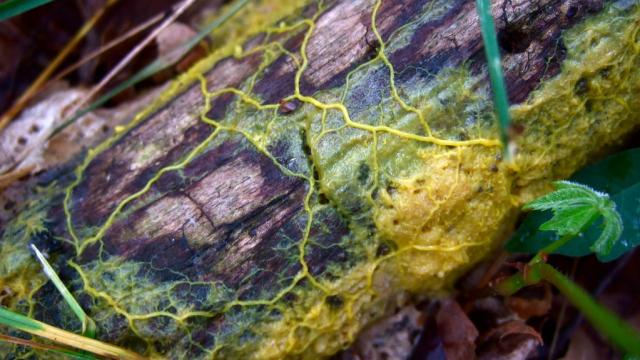Hey, you! Yeah, you all in the ceremonial robes about to perform a sacrifice in the name of the Almighty Blob! Stop it right now! Also, you over there, building the blob survival shelter. You may also stop.
This has gotten out of control. I know you all read that Reuters article, the one that stated that the Paris Zoological Park had acquired a “mysterious new organism” dubbed the “blob” in reference to a horror movie. And I know you all began to panic as you read that said blob “has no mouth, no stomach, no eyes, yet it can detect food and digest it,” “has almost 720 sexes, can move without legs or wings and heals itself in two minutes if cut in half,” and (in the words of Paris Museum of Natural History director Bruno David) “has no brain but is able to learn (…) and if you merge two blobs, the one that has learned will transmit its knowledge to the other.”
[referenced url=”https://gizmodo.com.au/2019/10/terrifying-blob-organism-with-720-sexes-has-no-brain-but-can-self-heal-and-transmit-knowledge/” thumb=”https://gizmodo.com.au/wp-content/uploads/2019/10/the-blob-2-410×231.jpg” title=”Terrifying ‘Blob’ Organism With 720 Sexes Has No Brain But Can Self Heal And Transmit Knowledge” excerpt=”I guess this is how we all die.”]
“We know for sure it is not a plant but we don’t really if it’s an animal or a fungus,” David told Reuters. “It behaves very surprisingly for something that looks like a mushroom (…) it has the behaviour of an animal, it is able to learn.”
It is only natural that society would split into two camps. One welcoming the blob as a sort of deity, a New God if you will, omnipotent in its potent blob abilities — but possibly able to be swayed from absorbing humans by worship. The rest of you were similarly panicked, but decided your best chance was in building an underground Blobocalypse Ark to survive its reign of terror, or until it pops or something. That’s just part of being human, and I get it.
But I regret to inform you that while the blob is indeed somewhat mysterious, it is not new. It is the humble Physarum polycephalum, a slime mould, a detail that was only mentioned in small text in Reuters’ photo caption (and not in its tweets). As such, it poses no threat to us.
The ‘blob’: A mysterious new organism that looks like a fungus but acts like an animal https://t.co/9xsFBYFJyg. Follow @ReutersScience for more coverage pic.twitter.com/wnB71ZXHcx
— Reuters Top News (@Reuters) October 16, 2019
Physarum polycephalum is a member of the phylum Mycetozoa, which is a group of amoeboid, aerial spore-producing protists. Protists are eukaryotic organisms that are not a plant, animal, or fungus, but that does not mean there’s all that much ambiguity as to what the blob really is.
It’s basically a massive single-celled organism (formed by the merger of many smaller specimens) with tons of nuclei, and it looks like branching dog vomit.
It can indeed move, but slowly enough that its progress can only be observed over several days. It’s not considered a fungus because it eats entire organisms instead of breaking down organic matter into chemicals, but those organisms are microbes like bacteria or fungal spores.
Sometimes the slime mould also moves to avoid light and into damp areas, sensing its environment through tubes filled with cytoplasm (the goo inside cells). The somewhat mysterious part is its ability to memorise certain things about its environment and solve complex problems despite lacking a nervous system.
That includes things like becoming habituated to unpleasant but non-harmful chemicals sitting in the way of its path to food, balancing its diet, and solving mazes and traps.
Scientists have studied whether slime moulds can be stimulated mechanically to activate “gates” similar to logic gates, making them useful for computing. But their main relevance to computing is their ability to solve complex issues like the Travelling Salesman Problem, which could offer insights into hardware-based information processing.
Other research has found it can share some of its acquired memories with other P. polycephalum that fuse with it to grow bigger. The exact mechanisms by which they do this remain somewhat unclear. However, some of the decisions it makes, such as where to move and what to eat, appear to be made by committee, per the Guardian:
Every part rhythmically expands and contracts, pushing around the fluid inside. If one part of the plasmodium touches something attractive, like food, it pulses more quickly and widens. If another part meets something repulsive, like light, it pulses more slowly and shrinks. By adding up all of these effects, the plasmodium flows in the best possible direction without a single conscious thought.
More recent evidence has suggested that habituation to negative stimuli like the unpleasant chemicals or high salt concentrations may be a matter of a P. polycephalum just absorbing the chemical, thus growing used to it.
This might also explain how a slime mould shares memories: when it merges with another, the absorbed chemicals are shared too. Other behaviours, like seemingly knowing where it’s been, may also be explained by the trail of slime it leaves behind as a marker.
As for the claim that it has hundreds of sexes, well, that’s less exciting than you may think. The mould grows spores that hatch into amoebas containing only some of its genetic information, which then have to merge with compatible ones into zygotes that then themselves merge with others to form the big, single-celled version.
Also, slime molds are not new and have been around for an estimated billion years or so.
So, in other words, this so-called new “blob” is actually a well-known organism that has been studied for decades and is just a cool, harmless addition to the Paris Zoo… No, wait! Don’t sacrifice me to the blob. Nooooooo!
